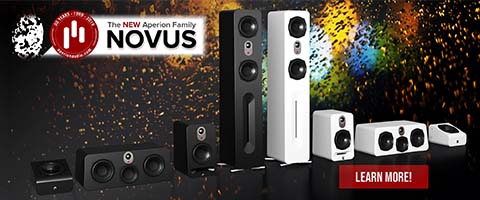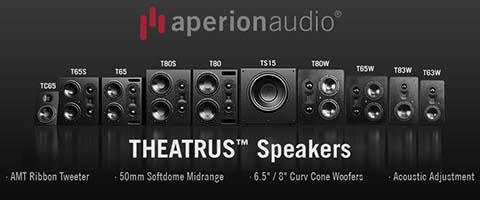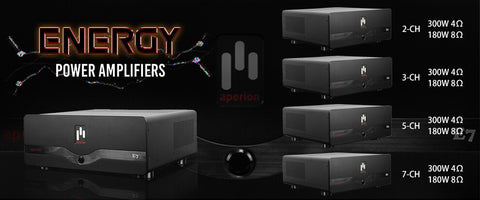 Do you have a small room but don’t want to compromise on sound? This article will help you get big sound from small room speaker systems without breaking the bank. Here at Aperion we always start with our customer’s room in order to provide the best recommendation for an optimal system for each unique space. Just as none of our customers are exactly alike, neither are the rooms into which they are putting their speakers.
Do you have a small room but don’t want to compromise on sound? This article will help you get big sound from small room speaker systems without breaking the bank. Here at Aperion we always start with our customer’s room in order to provide the best recommendation for an optimal system for each unique space. Just as none of our customers are exactly alike, neither are the rooms into which they are putting their speakers.
“Small” Room? Who you calling small?
So what are the best speakers for a small room? First, let’s take a little closer look at the definition of a small room. In general, any room that is 15′ x 15′ or smaller would be considered a small room, at least in terms of one that you are putting a speaker system into. Usually in a room of that size, the listener will be less than 10 feet from the speakers and in many cases quite a bit closer. Of course room size isn’t exactly scientific, so take the 15′ x 15′ designation with a grain of salt. If your room is 16′ x 16′ you could still rightfully call it “small” or “medium” so in that case you may need to use other criteria to really hone in on the best speakers. One other thing on the definition of room size, keep in mind that this is for a closed room. If your listening area is 15′ x 15′, but really its part of a larger 25′ x 30′ room, then that’s actually just a large room. The sound from the speakers doesn’t know to stop at the edges of your listening area and that means you won’t get as much reflected sound as you would in a smaller enclosed space.
Speaker Types to Match Your Space
In a small room, your typical best sonic bang for your buck would be a bookshelf style speaker. Yes, towers give you a fuller sound, but if you are in a small space a bookshelf should fill the room quite nicely. And since your floor space is limited, a bookshelf will give you the freedom to place the speaker on a shelf or other spot where it isn’t taking up valuable real estate. Finally if you are sitting really close to the speaker, say under 8 feet or so, the sound from a larger cabinet speaker may not be fully dispersed and you will not get the true benefit of a larger speaker. Having said all of that, there are cases where you could put a small tower, such as our Novus 6T into a small room and still have it be a good sonic fit. In most cases this would be a good fit for people that are using the speaker for a good amount of music, as opposed to home theater, and sitting at least around 8 feet or further from the speaker is still a good rule of thumb.
However, if you are really tight on space then an in wall or in ceiling speaker, also known as architectural speakers, may be the best choice. An in wall or in ceiling speaker can sound amazing, however because in ceiling speakers have the best sound fairly close to directly underneath them, they do present a bit of a sacrifice in sound quality for front and center channel usage. For a 5.1 system in a small room, an in wall or in ceiling system can start to make a lot of sense since you may not have room for all of those speakers. In walls will be ideal for the front and center and then in ceiling or in wall for the surround channels. For music listening, a cabinet speaker will provide the most realistic soundstage and stereo imaging. So if music is a good chunk of your usage, you might consider a hybrid system with cabinet speakers for the front and center channels and then architectural speakers for the surround channels.
- - - - - - - - - - - - - - - - - - - - - - - - - - - - - - - - - - - - - - - - - - - - - - - - - - - - - - - - - - - - - - - -
How Many Speakers Do I Need?
In terms of configurations for home theater, it will be difficult to justify a 7.1 system in a small room. The rear surrounds will need to be at least three feet behind the side surrounds in order for there really to be a sense of movement between those two sets of speakers and commonly getting that amount of separation between the speakers just isn’t possible in a smaller room. However, a 5.1 system can usually be installed and give you a great surround experience. Just keep in mind that you need the surround channels to be either directly to the side or behind the listening position. You can get away with the surround channels just a few inches in front of you and then angled back at the listening position, but it’s not ideal. It’s really not recommended to go any further than a few inches in front of you as you will lose the surround effect more and more the closer the surrounds get to the front and center channels. If there is nowhere to the side or behind the seating area, then it is probably best to go with either a 3.1 system. However, now with Dolby Atmos there is a way to augment 3.1 or 5.1 systems in a small room by adding height channels to your front stage. The nice thing about height channels is that they can be utilized in just about any size room and can really add another dimension to your movies, with sounds moving up and down across your speakers in addition to side to side and front to back. If you imagine a movie scene with rain falling on a roof, a properly configured Atmos system can make it sound as if the rain really is falling directly above your listening position.
Finally the last piece of the puzzle; the subwoofer. The good news is that since the vast majority of home audio subwoofers have their own volume control, it is much easier to dial in the output of this speaker in a small room to keep it from overwhelming the other speakers. So really, you can put as large of a sub as you want into a small room. A smaller sub shouldn’t have trouble filling the space, and here the closed room factor is critical, but a larger sub will kick out deeper bass. One caveat, don’t put the sub too close to the listening position or it may be difficult to turn it down enough to get it to blend in with the other speakers. Ideally the sub is placed in the same plane as the front and center speakers but you can also place it about one third of the length of the room, again just as long as you don’t end up sitting right next to it. Now many of these small rooms may be in an apartment type scenario, so in that case make sure that the neighbors won’t be complaining about their walls shaking constantly. If you can hear what’s going on in their apartment, it’s a good bet they can hear what’s happening in yours. In that case, a smaller sub is probably the best option.
That covers the ins and outs of dialing in the perfect sound for your diminutive space, thanks for reading and as always, happy listening!

Complete Your Sound System Solution

Sign up for our newsletter below, and join our social media groups to stay up to date with the latest news and information from Aperion Audio!
 |
 |









 https://www.aperionaudio.com
https://www.aperionaudio.com